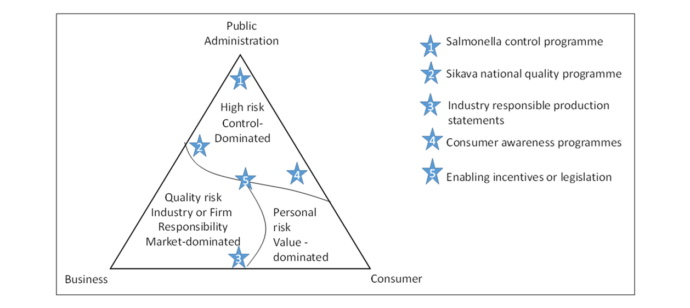The high level of food safety and security of food supply have special meaning in a small national economy like Finland with its 5,5 million inhabitants and a strong dependence on foreign trade. Unlike in many other EU member states, in Finland the foodstuff industry relies on a strong tradition of self-regulation. This is made possible by active cooperation between administration, research and business life.
 Photo by Monserrat Soldú on Pexels
Photo by Monserrat Soldú on Pexels
EU regulation: Businesses are principally responsible for ensuring food safety
Modern Food Governance is an interplay between public and private actors aligning both interests and capacity to manage food safety. Such hybrid food governance is importantly result of coordinated public and private regulatory activities which also transcend state boundaries (Verbruggen & Havinga 2017). Consumer is a central actor in aligning incentives and raising food safety levels in practice (Weckström-Lindroos & Lonka 2018).
The principal responsibility for food safety according to the EU regulation lies with the private actors. EU allows food businesses wide discretion to decide about their actual measures to meet the minimum legal requirements. The focus in public control of safety measures have over the years transitioned from the product controls to monitoring the food production processes.
Entering the EU in 1995 resulted in harmonization of the Finnish foodstuff and food safety legislation with the Community legislation. The EU General Food Law (GFL) issued in 2002 constitutes a harmonized legal framework for food safety law in Europe. The EU Food Law incorporated in the Finnish legislation as the Finnish Food Act in 2006 178/2002/EC.
Hybridization of Food Governance in Finland
Food industry is an important employer in Finland. It is the biggest manufacturer of consumer goods and fourth largest industrial sector after the metal and chemical industry and forestry. Safeguarding public health has played a central role in the evolution of the country from its agro-industrial past to the present welfare state. Prevention of food borne diseases is still essential target of national policy.
The Finnish food industry and producer associations have been active in developing voluntary certification schemes for food product traceability, quality and animal welfare since the 1980’s. EU membership caused some specific challenges for this work. The Finnish food industry had to keenly consider, how to adjust to the EU internal market principles. These principles underline e.g. that certification schemes may not lead to restrictions based on the national origin of producers or otherwise impede the single market.
Societal demand for certain quality characteristics of the product or its production process drives development of voluntary certification schemes. From the industry perspective they help both to meet the legislative demand for food safety and improve their performance in compliance with the customer demand.
The Finnish foodstuff legislation was reformed in 2021. A central target in revision was to streamline the legislation and lighten the administrative burden. The key features are that the implementation of regulation relies on self-control of the businesses and that the control measures are based on risk assessment. This new direction of regulatory mindset means that self-regulation and quality management systems will have even more weight in future.
Food Quality Governance in Finland as an EU member state
The Finnish Salmonella Control Program (FSCP)
In its Treaty of Accession to EU Finland reserved the right to implement stricter regulation on salmonella control than other member states. This regulation is called the Finnish Salmonella Control Program (FSCP). The objective of the FSCP is to ensure that Salmonella prevalence remains below 1 % in swine, bovine and poultry production as well as in meat and eggs derived from these animals. This program also grants additional guarantees required for importing eggs and meat to Finland from other member states.
The main difference between the European Union Zoonoses Directive and Finnish regulation is that FSCP sets measures as well for all levels of live animal production as for processing plants. The FSCP decree also takes into account the EU regulation on microbiological criteria for foodstuffs.
The industry-driven Sikava Pig Health Programme enables antibiotic free production
The Sikava (‘Piggy’) health register is a result of long development in the Finnish food animal industry on creating quality systems. This process is central for ensuring antibiotics free meat production in Finland. The coordinated work between the pork meat producers to reduce the outbreak of infectious diseases had started already in the 1970’s. The activities developed step by step to quality strategies of individual slaughterhouse actors in the 1990’s and ended up in the beginning of the millennium to an agreement of creating an integrated quality system for pork meat industry.
The important features of Sikava as a National Quality System are:
a) According to the documentation and traceable evidence collected in the pre-accreditation process, the meat produced can be estimated to fulfill the criteria for responsibly produced pork meat and to be of higher quality than the meat produced outside the quality system;
(b) The accredited sertification body ensures independent specialist control;
(c) Every pork meat producer can join the Sikava system and use the services. Precondition is to make a health-care agreement with a listed veterinarian and commitment to follow the rules;
(d) The Sikava health register ensures that the data on pig health is traceable for every individual all times;
(e) The planning and implementation of the system takes carefully into account the present and future market demands and potentials and it does not restrict competition by any unfair means.
Conclusions
Regulatory measures that enhance and enable private regulation to align consumer protection and economic interests also help to improve public food safety regulation. At the same time these measures enhance quality and risk management throughout the market. Figure 1 features how different measures link different actors in quality management sphere. Public administration is in charge of developing the binding regulation, i.e. legislative measures, which are targeted to manage high risks jeopardizing public health. Consumers drag the industry to develop responsible production programs and industry is pushed by market demand to improve the quality management systems to a higher level. In this model, enabling incentives and legislation (number 5 in figure 1) are seen to advance the alignment of interests of various actors resulting in creation of high food risk management quality system (Weckstöm, Lindroos & Lonka 2018).
 Fig 1. Division of responsibilities between public administration, industry and consumers in enabling high food risk management quality system (Weckström Lindroos, K. & Lonka, H. 2018)
Fig 1. Division of responsibilities between public administration, industry and consumers in enabling high food risk management quality system (Weckström Lindroos, K. & Lonka, H. 2018)
This article is based on a presentation by Dr. Lonka at the Nigerian Institute for Medical Research in Abuja, Nigeria 27 April 2023.
References:
- About SIKAVA pig health program: sikava.fi
- Weckström Lindroos, K. and Lonka, H. 2018. High quality food risk management system: comparing implementation of industry driven and public food safety regulation in Finland within the EU general food safety law framework. Renmin University Law Review – Food Safety Symposium Article Series 2018.
- Verbruggen, P. and Havinga, T. 2017. Hybridization of Food Governance. Edward Elgar.